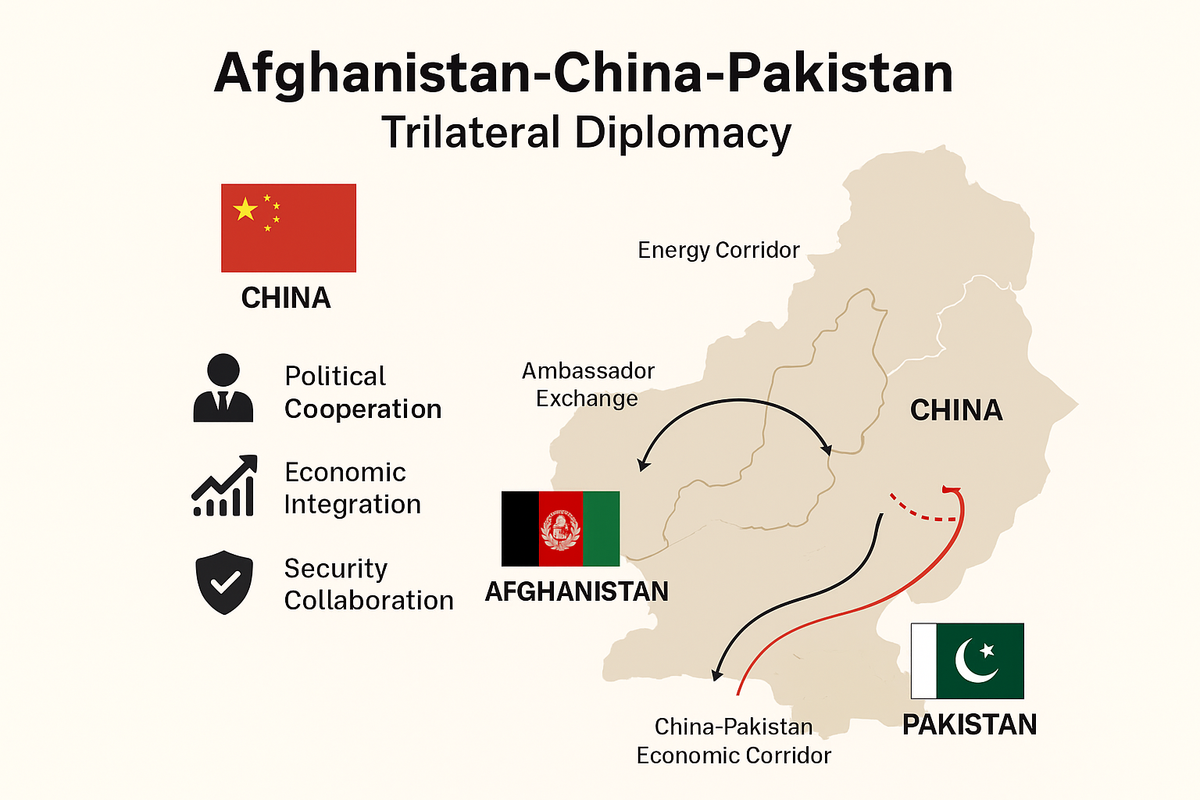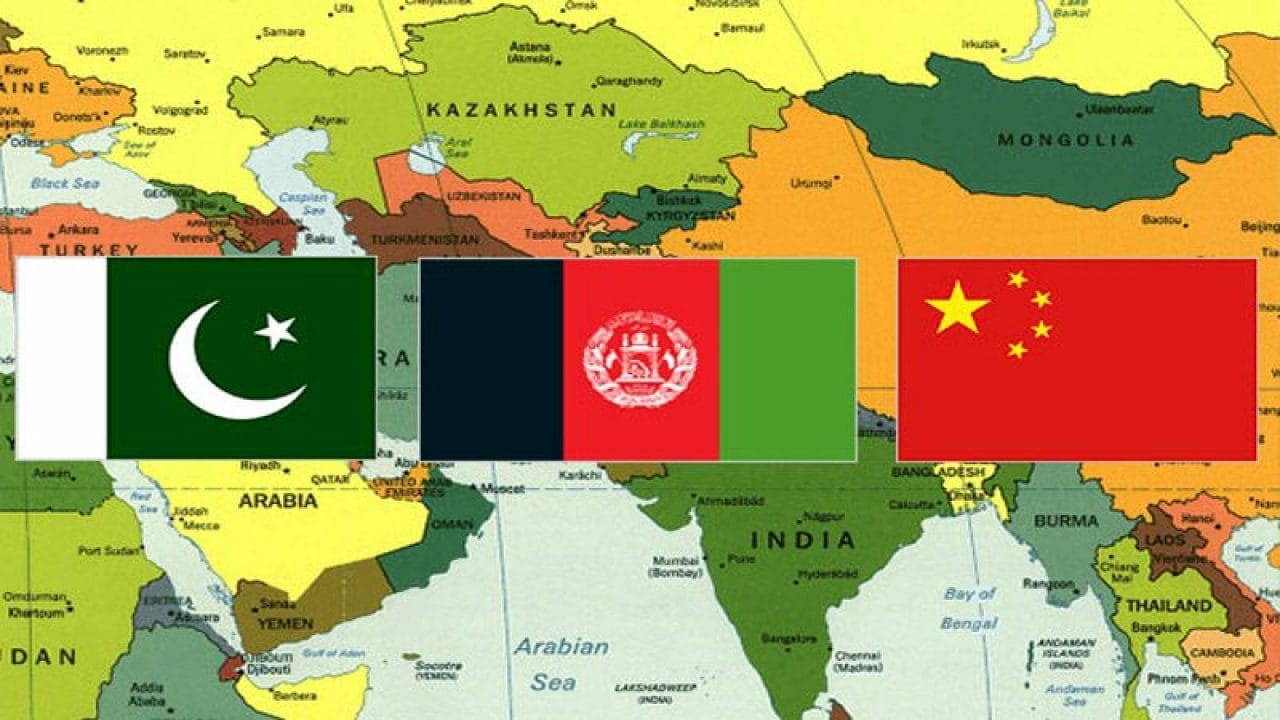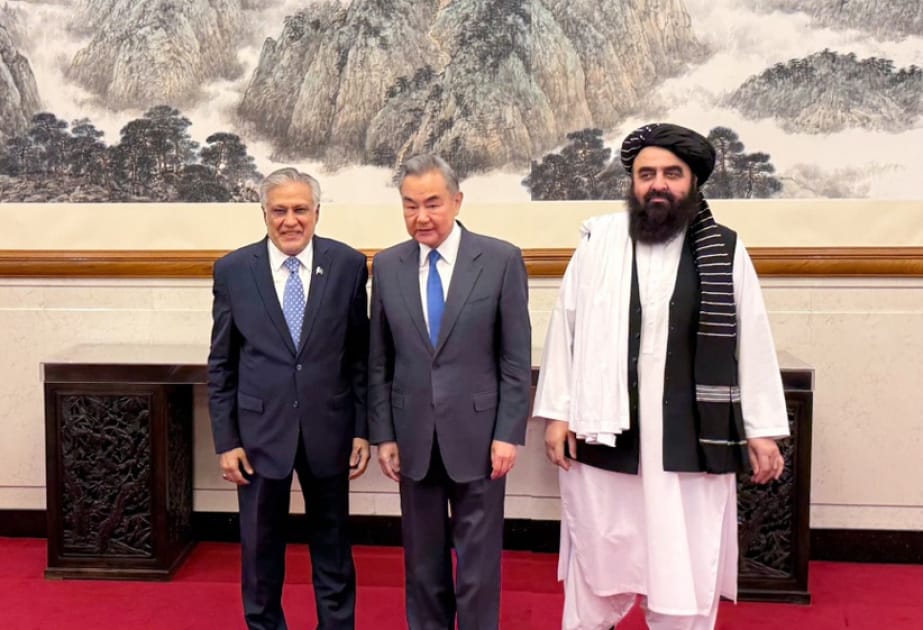The Kabul Accord: Can a Trilateral Alliance of China, Pakistan, and Afghanistan Reshape South Asia?
An in-depth investigative report into the latest trilateral foreign ministers' dialogue between China, Pakistan, and Afghanistan.

Written by Lavanya, Intern, Allegedly The News
KABUL, August 21, 2025
The air in Kabul, a city long synonymous with conflict and uncertainty, was charged with a different kind of energy this week. It was the energy of a geopolitical gambit, an ambitious play by China to solidify its influence in a region it considers vital to its strategic and economic interests. The sixth Trilateral Foreign Ministers' Dialogue, bringing together the top diplomats from China, Pakistan, and the Taliban-led government of Afghanistan, was more than a routine meeting; it was a carefully choreographed statement on the shifting balance of power in South Asia.
For a region long mired in instability and mistrust, the very notion of a functioning trilateral mechanism focused on peace and cooperation seems almost improbable. Yet, Beijing has managed to shepherd this dialogue, pushing its two historically uneasy neighbors to the negotiating table. The central question that hangs over this initiative is whether it can transcend the realm of diplomatic symbolism and forge real, tangible pathways toward lasting peace and development.
The Latest Diplomatic Play: Outcomes and Real Significance
The most significant outcome of the meeting, widely reported across regional and international media, was the formal reaffirmation to extend the China-Pakistan Economic Corridor (CPEC) to Afghanistan. While this has been a topic of discussion for years, the inclusion of the Taliban government in this agreement lends it new weight. For the Taliban, whose regime remains unrecognized by the majority of the international community and is grappling with severe economic sanctions, this is a much-needed political and economic victory. It offers a glimmer of hope for foreign investment and regional integration, which could help alleviate the country’s crippling humanitarian crisis.
The dialogue also produced a strong, unified front on counterterrorism. Pakistan’s Foreign Minister, Ishaq Dar, reportedly pressed the Afghan authorities to take "concrete and verifiable" action against terrorist groups like the Tehrik-i-Taliban Pakistan (TTP), which has been responsible for a surge in cross-border attacks. For China, security remains paramount, especially concerning the East Turkestan Islamic Movement (ETIM), a Uyghur militant group it fears could use Afghan territory to destabilize its Xinjiang province. The joint statement committed to strengthening cooperation on security and combating drug trafficking, but the true test will be in the implementation of these pledges. Without a genuine and demonstrable crackdown on militant groups, the foundation for economic projects remains shaky.
Finally, the meeting emphasized broader cooperation in areas like trade, transit, health, and education. This multi-faceted approach suggests a move away from a purely security-centric agenda to one of holistic regional development. However, the success of these initiatives is inextricably linked to the political stability and security environment on the ground.
A History of Uneasy Engagements: The Trilateral Timeline
The history of the China-Pakistan-Afghanistan trilateral dialogue is a case study in geopolitical fits and starts. Initiated by China in 2017, the mechanism was designed to mediate the fraught relationship between Islamabad and Kabul and create a more stable western flank for Pakistan's burgeoning CPEC projects.
- December 2017: The inaugural dialogue takes place in Beijing. The meeting is largely symbolic, establishing a forum for discussion on peace, counterterrorism, and cooperation. It first raised the idea of extending CPEC to Afghanistan.
- 2018-2020: The mechanism continues, but with limited tangible progress. The discussions are often overshadowed by escalating border tensions and diplomatic spats between Pakistan and the then-democratically-elected Afghan government.
- August 2021: The chaotic U.S. withdrawal and the Taliban's rapid takeover of Afghanistan throw the region into disarray. The trilateral dialogue is effectively put on hold as the international community grapples with the new reality. China, however, maintains its embassy in Kabul, signaling a pragmatic approach to the new regime.
- May 2025: The dialogue resumes with a significant meeting in Beijing. This marks the first high-level trilateral engagement since the Taliban’s return to power. A verbal agreement is made to extend CPEC to Afghanistan, and a plan is put in place to elevate diplomatic ties to the ambassadorial level.
- August 2025: The latest meeting, held for the first time in Kabul since the Taliban takeover, solidifies the commitments from May. The decision to extend CPEC is now a formal agreement, moving the conversation from a theoretical possibility to a planned reality.
The progress over the years has been slow, often characterized by more setbacks than victories. The current moment, however, feels different. With the U.S. having vacated the scene, China has a clear opportunity to exert its influence, and both Pakistan and Afghanistan are keen to secure Beijing's political and financial backing.

CPEC and the Road to Kabul: A Corridor of Hope or a Pipe Dream?
The proposed extension of CPEC into Afghanistan is arguably the most ambitious part of the trilateral cooperation. For China, it's a critical component of its Belt and Road Initiative (BRI), a vast network of infrastructure projects aimed at connecting China to the rest of Asia, Europe, and Africa. A CPEC-Afghanistan link would provide China with a direct land route to Central Asia, allowing it to diversify its trade routes and tap into Afghanistan’s vast, and largely unexploited, mineral resources, including lithium and rare-earth elements.
For Pakistan, the extension of CPEC would not only enhance its role as a regional trade hub but also potentially unlock new economic opportunities for its struggling economy. It would also help improve its strained relationship with Afghanistan by creating a shared economic stake in the region's stability.
For Afghanistan, the promise of CPEC is a lifeline. The country’s economy is in tatters, with a severe humanitarian crisis affecting millions. The projects could bring much-needed jobs, infrastructure, and foreign investment. The hope is that the economic interdependence created by CPEC would give all three parties a vested interest in maintaining peace and stability.
However, the challenges are immense. The volatile security situation is the most significant hurdle. Any large-scale infrastructure project requires a stable and predictable environment, something that is far from guaranteed in Afghanistan. The risk of attacks on Chinese workers and projects by various militant groups is a major concern for Beijing. Furthermore, the lack of a fully recognized government and the continued international sanctions make it difficult to secure the necessary financing and technical expertise. Experts warn that without a fundamental shift in the security landscape, the CPEC-Afghanistan link may remain a "pipe dream" for the foreseeable future.
The Looming Security Question: A Trust Deficit
While the trilateral meeting produced a strong statement on counterterrorism, a deep-seated trust deficit remains, particularly between Pakistan and the Taliban. Pakistan has consistently accused the Taliban of providing a safe haven to the TTP, a claim the Afghan authorities deny. The TTP has been responsible for a string of deadly attacks on Pakistani soil, many of which have targeted Chinese workers and projects. The security of Chinese nationals working on CPEC is a top priority for Beijing, and it has repeatedly urged the Taliban to take action.
The Taliban, for its part, faces a difficult balancing act. Many of these militant groups have historic ties to the Taliban, and a full-scale crackdown could lead to internal friction and push these groups to ally with more extreme organizations like ISKP. China, with its own security concerns about ETIM, is also watching closely. The success of this trilateral effort hinges on the Taliban's willingness and ability to demonstrate a genuine commitment to security, something that has yet to be seen on a consistent basis.
Beijing's Grand Strategy: Filling the Geopolitical Vacuum
China's role in this trilateral diplomacy is not merely that of a well-meaning neighbor; it is a calculated and strategic move to expand its influence in a region where the U.S. has retreated. By positioning itself as a mediator and a primary economic partner, Beijing is subtly but surely building a new regional order. This is a direct counter-narrative to the Western approach, which has largely focused on isolation and sanctions against the Taliban. China’s engagement is a pragmatic one, driven by its own security and economic interests.
This move ties directly into the broader U.S.-China rivalry. With the U.S. increasingly focused on containing China in the Indo-Pacific, Beijing is consolidating its power on the Eurasian landmass. The trilateral framework, coupled with the BRI, is a powerful tool to achieve this. It not only secures China's western borders but also extends its economic and political reach, challenging the U.S.-led global order. This new axis of power has significant implications for other regional players, most notably India, which views the growing China-Pakistan-Afghanistan nexus with unease.

Conclusion: The Road Ahead and a Call to Action
The trilateral foreign ministers' dialogue represents a strategic bet on regional stability. The main agreements, extending CPEC, enhancing counterterrorism cooperation, and fostering economic ties, are ambitious and, if successful, could have a transformative impact on South Asia. However, the path forward is fraught with challenges, from deep-seated security concerns to the political and economic instability of Afghanistan. The success of this initiative is a test of China's diplomatic prowess and the three nations' ability to overcome decades of mistrust and conflict. The road to peace is not paved with rhetoric, but with verifiable actions and a shared commitment to a more prosperous future.
Unanswered Questions and the Path Forward
Is this a sustainable economic model? Will the CPEC extension truly lead to equitable development for Afghanistan, or will it exacerbate existing power imbalances and lead to debt dependency on China? How can the three countries ensure transparency and accountability in the implementation of these projects?
Sources
The Associated Press, The Diplomat, The Economic Times, Arab News, Global Times, Reuters.




